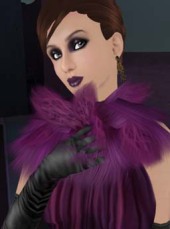Edited Jan 12, 2009 – With the release of Release Candidate 1.22 the avatar mesh has now been fixed so it shows as a default white rather than grey shade. This is the reason why clothing on avatars would be darker than the attachment prims even if they had the same texture. Once 1.22 goes live as the default client, using these settings, you should no longer need to tint prims or wear facelights! To allow for this brighter avatar mesh I’ve lowered two settings: Scene Gamma (now default at 1.00) and Ambient (now default at 0.64). All other settings are the same. I’ve also included in the tutorial how to set this automatically as your default lighting whenever you log on. – Caliah
Some of you may remember the old WL presets I made several versions back. As those are long obsolete, I’ve come up with a new preset which works on the current client based on one of the default midday settings. With this preset your avatar will look better with local lighting and atmospheric shaders (no need to turn them off unless in a build full of local lights). It’s recommended to use a very faint face lamp or none at all in public (consider it as doing the public a service in that your face lamps won’t be blinding anyone else on WL!). Note that the lighting is uniform no matter which direction you’re facing. If you do opt to go without a face lamp you can raise the Ambient Intensity (I) value to compensate. I’ve set it to 0.64-0.70 here for the outdoors, but lower settings are recommended for builds with a lot of lighting.*
You can just download this preset here and place the file directly in C://Program Files/Secondlife/app_settings/windlight/skies or follow this guide to set it manually. NOTE: If you are using RC 1.22.xx it will save the preset to the C:\Documents and Settings\user\Application Data\SecondLife\user_settings\windlight\skies directory. While the path is harder to remember this enables you to keep your settings across different installs of the SL client. Save it there if you prefer.


Recommended Face Lamp (Versions 1.21.xx and below)
I’ve made two face lamps, one warm (with a slightly orange light) and one white. I’ve put a box in the Muse lobby that will give you the in-world version of this tutorial in a notecard that has the lamps and some helpful pictures.
Open World > Environment Settings > Environment Editor and click on Advanced Sky, then click on “New” and save under a filename you remember. I’ve named my preset OptimisedWL.
The Atmosphere Tab
This is largely to improve the quality of the horizon and has little bearing on the lighting itself, -except- for the Max Altitude, Density/Distance multiplier values. You can tweak the other settings to your satisfaction to get better skies.

Blue Horizon: R: 0.12, G: 0.12, B: 0.16, I: 0.16
Haze Horizon: 0.09
Blue Density: R: 0.32, G: 0.59, B: 1.00, I: 1:00
Haze Density: 0.65
Density Multiplier: 0.18
Distance Multiplier: 2.0
Max Altitude: 188
Lighting Tab
I’ve set Red and Green values slightly higher to give the light a warmer “sunlit’ tone, but you can make all RGB values equal for a whiter, more neutral light. If you want brighter light you can raise Ambient using the “I” (Intensity) slider. A range of 0.64-0.77 is recommended, combined with Scene Gamma of 1.00-1.22. Note that you may have to lower both Ambient and Scene Gamma if you regularly visit builds with a lot of local lights.

Sun/Moon Color: R, G, B and I at 0.086
Sun/Moon Position: 0.000
Ambient: R:0.64, G:0.64, B:0.63, I:0.67 or R: 0.70, G: 0.67, B: 0.66, I: 0.70 (second setting is brighter)
East Angle: 0.16
Sun Glow: Focus: 0.10 Size 1.75
Scene Gamma: 1.00-1.15
Star Brightness: 0.00
The Clouds Tab
The only difference with the clouds tab from any default preset you might have is the coverage. I’ve set it to low (exactly 0.13).

Cloud Coverage: 0.13
As always, you can fine-tune these settings to suit your particular preference 🙂 Press New and save it under a name you prefer.
Using This Setting As Your Default
If you want to dispense entirely with the day and night presets and have this setting on all the time, do the following:
Press the button marked Day Cycle Editor in the Advanced Sky Editor menu. This will give you a box where you can specify what preset to cycle through every three hours (keys).

You don’t need this if you want this WL setting to be your default lighting all the time. To discard them press Delete Key several times until only one key remains.

When you have only one key left, click on the drop-down menu below Key Preset and choose the name of the Optimised WL setting you saved above (mine was CalWL3).
Press Save Test Day to save your changes. No more need to set this every time you log in!
Note – in most current WL settings old facelamps are much too bright; it would be best to have a friend check if yours is.
* Sadly nothing can be done about local lights if you go shopping and happen to pop into a build that’s full of them (apart from turning off atmospheric shaders), but a politely worded notecard to the designer or owner may help convince them to update their lighting methods.
 Subscribe to the RSS Feed
Subscribe to the RSS Feed















